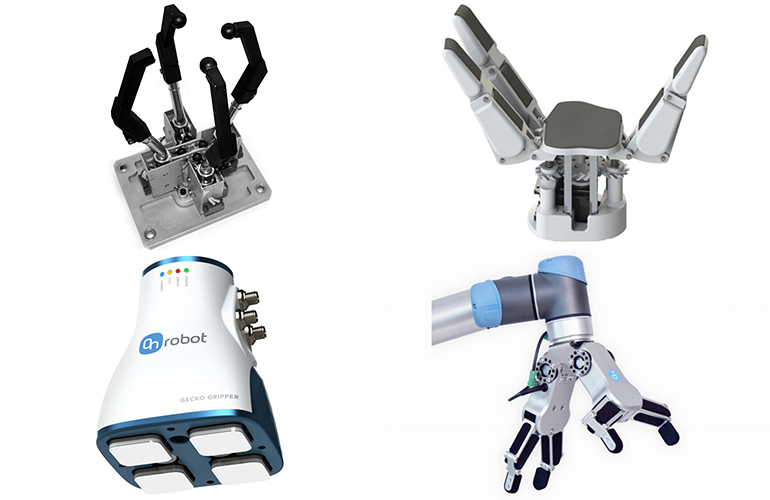Molecular robots that work cooperatively in swarms
Google researchers teach robots to learn by watching

Different robot end effectors.
Roboticists usually teach robots new tasks by remotely operating them through performing a task. The robot then imitates the demonstration until it can perform the task on its own.
While this method of teaching robots is effective, it limits demonstrations to lab settings, and only programmers and roboticists can do the demonstrations. A research team at the robotics department at Google has been developing a new way for robots to learn.
Humans learn by watching all the time, but it’s not a simple task for robots to take on. This is difficult for robots because they look different than humans. For example, a robot with a two-fingered gripper won’t gain much knowledge about how to pick up a pen from watching a human with a five-fingered hand pick one up.
To tackle this problem, the team introduced a self-supervised method for Cross-Embodiment Inverse Reinforcement Learning (XIRL).
This method of teaching focuses on the robot learning the high-level task objective from videos. So, instead of trying to make individual human actions correspond with robot actions, the robot figures out what its end goal is.
It then summarizes that information in the form of a reward function that is invariant to physical differences like shape, actions and end effector dynamics. By utilizing the learned rewards and reinforcement learning, the research team taught robots how to handle objects through trial and error.
The robots learned more when the sample videos were more diverse. Experiments showed that the team’s learning method led to two to four times more sample efficient reinforcement learning on new embodiments.
The team has made an open-source implementation of its method and X-MAGICAL, its simulated benchmark for cross-embodiment imitation, to let others extend and build on their work.
X-MAGICAL was created to evaluate XIRL’s performance in a consistent environment. The program challenges a set of agent embodiments, that have different shapes and end effectors, to perform a task. The agents perform the tasks in different ways and at different speeds.

Demonstrating different shapes performing a task in X-MAGICAL. | Source: Google
The team also taught using real-world human demonstrations of tasks. They used their method to train a simulated Sawyer arm to push a puck into a target zone. Their teaching method also outperformed baseline methods.
The research team included Kevin Zakka, Andy Zeng, Pete Florence, Jonathan Tompson and Debidatta Dwibedi from robotics at Google, and Jeannette Bohg from Stanford University.
The post Google researchers teach robots to learn by watching appeared first on The Robot Report.
Soft robotic origami crawlers
A 7-foot-tall robot at Dallas Love Field is watching for unmasked travelers and curbside loiterers
Potential for social connection between humans and robots
Robots are learning to think like humans. Can they meet Amazon’s demands for speed?
Joystick-operated robot could help surgeons treat stroke remotely
Halma acquires underwater ROV maker Deep Trekker

Deep Trekker’s DTG3 ROV exploring an underwater shipwreck. | Source: Deep Trekker
Halma PLC has acquired Deep Trekker, an Ontario, Canada-based developer of submersible robots, for around $47 million on a cash and debt free basis. Deep Trekker will be managed as a standalone company and will join Halma’s Environmental and Analysis sector.
Deep Trekker’s line of underwater ROVs include the DTG3 ROV, which can reach a max depth of 200 m and has a battery life of up to eight hours, as well as two ROVs that can reach up to 305 m but have shorter battery lives. The Pivot ROV can run for up to three hours, while the Revolution ROV can run for up to six.
The company’s ROVs are used for underwater inspection and tasks in a variety of industries, including aquaculture, infrastructure, energy, search and recovery, commercial diving, defense and ocean science.
Deep Trekker brought in over $15 million in 2021, with a return on sales above Halma’s target range of 18%-22%. Around two-thirds of the company’s revenue comes from business in the Americas, while 15% comes from Europe.
“Deep Trekker is an exciting addition to Halma, which is highly aligned with our purpose, both in terms of helping to ensure a cleaner environment, and in improving the safety of underwater inspection,” Andrew Williams, group chief executive at Halma, said. “It offers new opportunities for growth in a number of markets, driven by increasing health, safety and environmental regulation, and global efforts to address climate change, waste and pollution.”
Halma is a global group of technology companies that includes Ocean Insight, a company that develops spectroscopy equipment and software, and Palintest, a manufacturer of water analysis technologies. It is based in the UK, but has major operations in mainland Europe as well as in the US and Asia.
Deep Trekker was founded in 2010, and has sold its devices in over 99 countries. It’s headquartered in Kitchener, Ontario, Canada and has an additional office in Latin America.
The post Halma acquires underwater ROV maker Deep Trekker appeared first on The Robot Report.